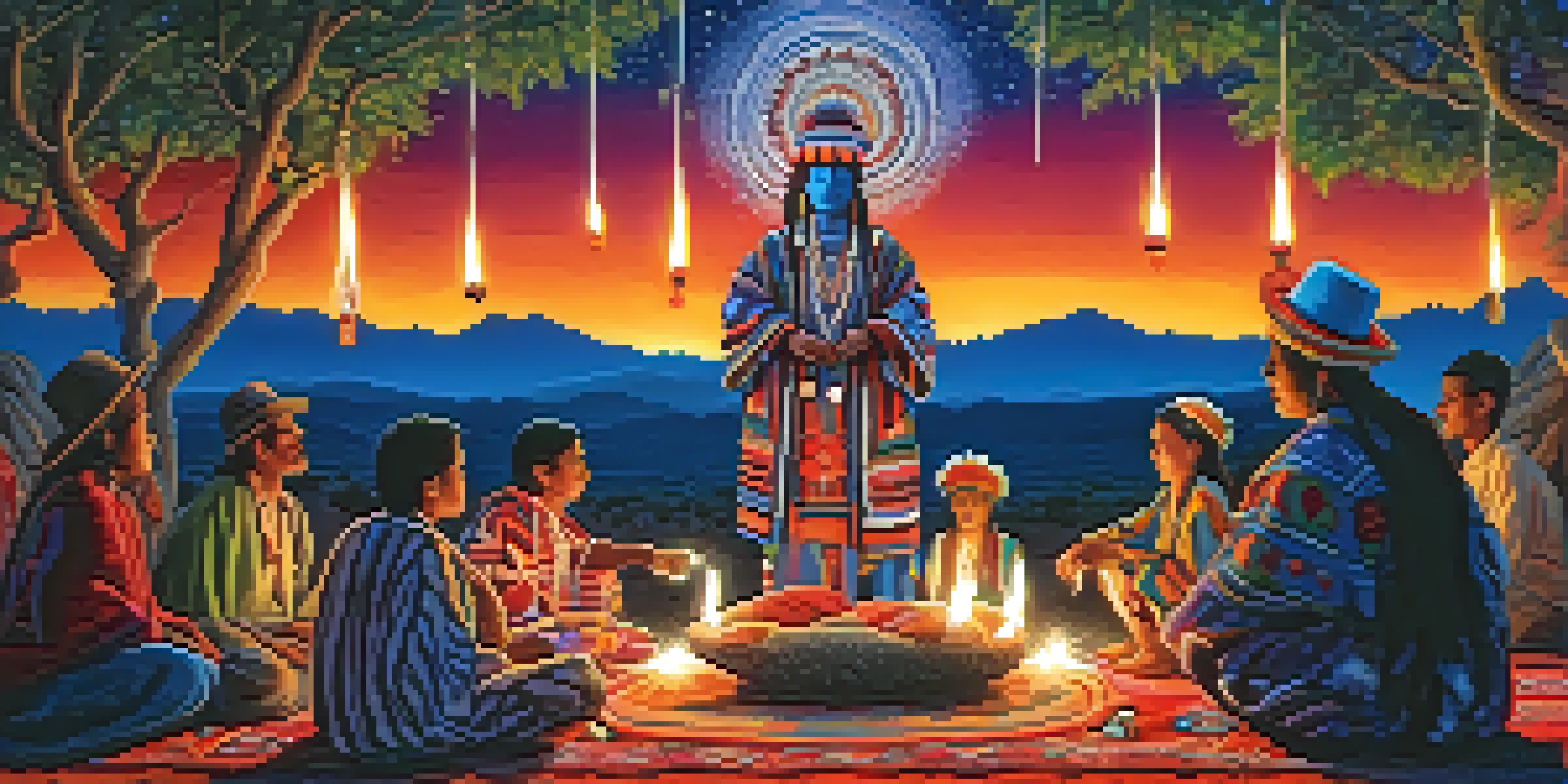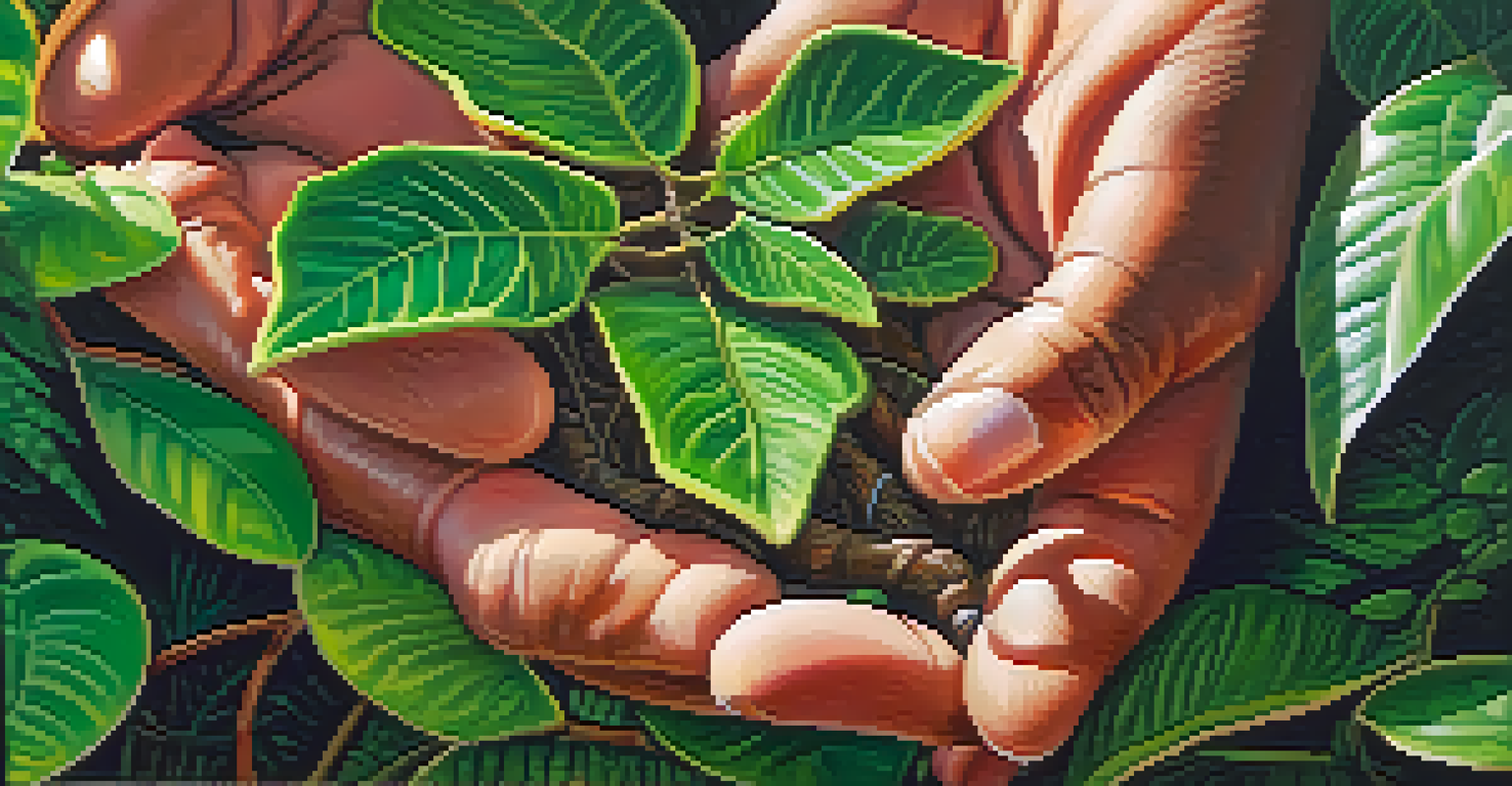Entheogens in Indigenous Rights Activism

Understanding Entheogens and Their Cultural Significance
Entheogens are substances that can induce altered states of consciousness, often used in spiritual or religious contexts. For many Indigenous cultures, these natural substances play a crucial role in rituals and healing practices. They are more than mere tools; they embody a deep connection to the land, ancestors, and the cosmos.
Entheogens are not just substances; they are bridges to our ancestors and the cosmos.
For example, the use of peyote by the Huichol people in Mexico illustrates how entheogens are interwoven with cultural identity. This sacred cactus is not just consumed for its psychoactive effects but is part of a larger narrative of creation, spirituality, and community bonding. Understanding this cultural significance is essential for grasping the broader implications of entheogen use in Indigenous activism.
As the world becomes increasingly aware of the power of these substances, it’s vital to respect and acknowledge their traditional uses. This respect is foundational when discussing Indigenous rights, as it underscores the importance of cultural heritage and autonomy in the face of modern challenges.
The Role of Entheogens in Healing and Spiritual Practices
Many Indigenous communities use entheogens as a means to heal both physically and spiritually. These substances are often integrated into traditional medicine, community rituals, and spiritual ceremonies, providing a sense of connection to the collective consciousness. This holistic approach to healing contrasts sharply with Western medical practices, which often prioritize individualism.

For instance, Ayahuasca, a powerful brew from the Amazon, is used in ceremonies that promote both psychological healing and spiritual growth. Participants often report profound insights, emotional releases, and a strengthened connection to their heritage. Such experiences can empower individuals and communities, reinforcing their commitment to cultural preservation and activism.
Cultural Significance of Entheogens
Entheogens are integral to Indigenous rituals, representing a deep connection to culture, spirituality, and community.
In this way, entheogens serve not only as tools for healing but also as catalysts for social change. By fostering a deeper understanding of their identity and purpose, individuals are often inspired to advocate for the rights of their communities, emphasizing the need for recognition and respect in contemporary society.
Indigenous Rights and the Fight Against Criminalization
The criminalization of entheogens poses significant challenges for Indigenous communities that rely on these substances for their cultural practices. As governments around the world impose restrictions on the use of these natural resources, Indigenous rights activists strive to reclaim their cultural heritage and assert their right to use entheogens freely. This struggle highlights the intersection of law, culture, and identity.
To respect Indigenous rights is to recognize the deep cultural roots of entheogens and their significance in healing and community.
For example, in the United States, the Native American Church has fought for the legal use of peyote in religious ceremonies, challenging the broader narrative that often demonizes these practices. Their activism underscores the importance of legal protections for Indigenous rituals, offering a compelling argument for the respect of cultural rights in the face of systemic oppression.
As the conversation around entheogens evolves, activists are increasingly calling for policy changes that recognize the unique relationship Indigenous peoples have with these substances. This advocacy not only seeks to protect cultural practices but also aims to dismantle the stigmas associated with entheogens, fostering a more inclusive dialogue about their benefits.
Modern Activism and the Entheogen Renaissance
In recent years, there has been a resurgence of interest in entheogens, often referred to as the 'entheogen renaissance.' This movement is not only about personal exploration but also aligns closely with Indigenous rights activism. As more people become aware of the cultural significance of these substances, there is a growing push for their decriminalization and integration into mainstream healing practices.
Activists are working to bridge the gap between traditional Indigenous practices and contemporary therapeutic uses. This includes advocating for policies that honor Indigenous knowledge systems while also promoting safe and respectful use of entheogens in a broader context. The blending of these perspectives can create a richer understanding of entheogenic practices and their potential benefits.
Advocacy for Indigenous Rights
The criminalization of entheogens challenges Indigenous communities' cultural practices, prompting activism for legal recognition and respect.
The entheogen renaissance also opens the door for dialogue about reparative justice. By acknowledging the historical wrongs inflicted upon Indigenous communities, modern activists can advocate for policies that not only respect traditional practices but also address the ongoing impacts of colonization.
Cultural Appropriation vs. Cultural Appreciation
As interest in entheogens grows, the line between cultural appropriation and cultural appreciation becomes increasingly blurred. Many non-Indigenous individuals are drawn to these substances for their psychoactive effects without understanding their deep cultural roots. This can lead to a commodification of sacred practices, undermining the very cultures that have preserved them for generations.
For instance, the commercialization of Ayahuasca retreats has raised concerns among Indigenous leaders about the exploitation of their traditions. While these experiences can be transformative, it is crucial to engage with Indigenous communities in a respectful manner that honors their traditions and knowledge. This involves seeking permission, supporting local economies, and prioritizing the voices of Indigenous practitioners.
Engaging in genuine cultural appreciation means recognizing the historical context of entheogens and the importance of consent. By fostering respectful relationships, non-Indigenous individuals can contribute positively to the ongoing conversation about entheogens and Indigenous rights, rather than perpetuating cycles of exploitation.
The Intersection of Environmental Justice and Entheogens
The environmental impact of entheogen harvesting is another critical aspect of Indigenous rights activism. Many entheogens, such as peyote and Ayahuasca, are sourced from specific ecosystems that are often threatened by deforestation, climate change, and exploitation. Protecting these plants and their habitats is essential not only for Indigenous cultural practices but also for global biodiversity.
Indigenous communities often serve as stewards of the land, possessing invaluable knowledge about sustainable practices and the interconnections of ecosystems. As advocates for environmental justice, these communities emphasize the importance of preserving their traditional lands and the plants that grow there. This intersection highlights how the fight for entheogenic rights is part of a larger struggle for environmental sustainability.
Environmental and Cultural Justice
The protection of ecosystems where entheogens grow is essential for both Indigenous rights and global biodiversity.
By aligning the goals of Indigenous rights activism with environmental conservation, activists can create a more holistic approach to protecting both cultural and ecological heritage. This synergy underscores the importance of viewing entheogens not just as substances, but as integral parts of a larger ecological and cultural system.
Looking Forward: The Future of Entheogens in Activism
As the conversation around entheogens and Indigenous rights continues to evolve, it’s essential to maintain a focus on collaboration and respect. Future activism will likely hinge on building alliances between Indigenous communities and those interested in entheogens, fostering a dialogue that emphasizes mutual respect and understanding. This collaborative spirit can pave the way for more equitable policies.
Education will play a crucial role in this process, helping to demystify entheogens and their cultural significance. By providing accessible information and resources, activists can empower individuals to engage thoughtfully with these substances, cultivating a more informed public discourse. This knowledge-sharing can also help combat stereotypes and promote a more nuanced understanding of Indigenous practices.

Ultimately, the future of entheogens in activism is about honoring the voices of Indigenous peoples and ensuring that their rights are recognized and respected. By prioritizing their perspectives, we can create a more inclusive narrative that celebrates the rich cultural heritage surrounding entheogens while advocating for justice and healing in our interconnected world.